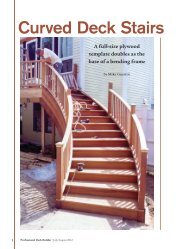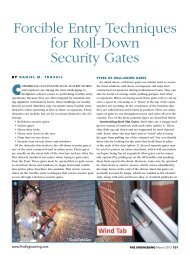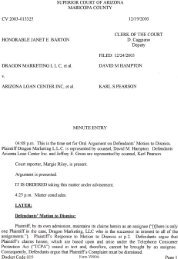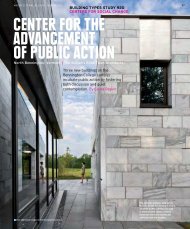Residential Architect March/April 2012 - American Business Media
Residential Architect March/April 2012 - American Business Media
Residential Architect March/April 2012 - American Business Media
You also want an ePaper? Increase the reach of your titles
YUMPU automatically turns print PDFs into web optimized ePapers that Google loves.
architectresidentialYEARA MAGAZINE OF THE AMERICAN INSTITUTE OF ARCHITECTSMARCH . APRIL <strong>2012</strong><strong>2012</strong>residential architectdesign awardsjonathan segal’s“the charmer”wins the jury’stop prize
contents march . april <strong>2012</strong>departments11 from the editor13 aiarchitect17 practiceHow architect spouses are dealing with thedown economyfeatures27 residential architectdesign awards <strong>2012</strong>28 project of the yearresidential architectdesign awards <strong>2012</strong>Read about the 36 projects that were granted design awards by our six-member jury.by Meghan Drueding, Nigel F. Maynard, Cheryl Weber, LEED AP, and Bruce D. Sniderpage 28page 49 page 45Cover photo: Danny Turner; top photo: Matthew Segal; above left photo: Erik Kvalsvik; above right photo: Mike Sinclair Photographer32 custom / less than3,000 square feet36 custom / more than3,000 square feet42 renovation46 restoration/preservation51 multifamily53 single-familyhousing59 affordable housing65 architectural interiors67 light commercial71 outbuilding73 kitchen74 bath77 architectural detail79 campus housing80 on the boardsra onlinerada judgingView our videos online that offer a behindthe-sceneslook at the <strong>2012</strong> jury process.r e s i d e n t i a l a r c h i t e c t / m a r c h . april <strong>2012</strong> 7
esidential architectdesign awardsthe charmer, sandiegojonathan segal faiasan diego
architectc , builder, anddeveloperJona-thanSegal, FAIA, has always admiredthe California courtyard housingcommunities of the1920s. “There’sa wonderful feeling about them,”he says. “Theirproportion and scale, their landscaping.g.” Heusedthem as a model for The Charmer, a 19-unitmultifamily project in SanDiego’s Litittltle Italalyneighborhood. The Charmer takes the pedestrianfriendlyplanning of historic courtyard apartmentsand combines it with restrained moderndesign,creating such an appealing place to live that the<strong>2012</strong> residential architect Design Awardsjudgesselected it as Project of the Year. “It resonatescompletely,” said a juror. “It has a lovely sense ofscale that relates to the neighborhood. There’s areal sense of humanity and livability.”Segal has been working in LittleItalysincethe1990s, boldly designing, building, and developinginnovativehousingandmixed-use projects. WithThe Charmer,he and his co-desesigner and son,Matthew Segal, followed their typical strategy ofstaying fairly small-scale andavoiding standardmultifamily featuressuch as underground parking,elevators, and indoor hallways. “We’re trying tokeep it very urban, yet keep it to two to three sto-ries,”Jonathan Segal says. “That’s whatwe likebest. At that height we don’t have undergroundparking requirements, and we cando the buildingmaterials ourselves.”Residents can choose from six one-bedroomcontinued on page 31
In addition to the main courtyard,patios, balconies, andoutdoor fireplaces help residentsspend as much time as theyplease enjoying San Diego’sbalmy climate.principal in charge/general contractor/developer/land planner/landscape designer/interior designer:Jonathan Segal, FAIA, Jonathan Segal FAIA; projectdesigner: Matthew Segal, Jonathan Segal FAIA; stuccoconsultant: Andrew Duncan, dub, San Diego; projectsize: 360 square feet to 1,200 square feet per unit; site size:0.7 acre; construction cost: $105 per square foot; rentalprice: $900 to $2,400 per month; units in project: 19 (notincluding commercial space); photography: Matthew Segal,except where noted . Visit www.residentialarchitect.com forproducts and additional images.30www.residenti a l architect.comr esidential architect / an aia magazine
12residential architectdesign awardsPlaster fins (top) deflect soundscoming from the nearby freeway.Asphalt shingles used as sidingcreate a soft, unexpected texture,as does permeable paving.bungalows grouped around a central courtyard;10 three-bedroom units placed outside the bungalows,toward the perimeter of the site; or threetwo-bedroom units overlooking the courtyard.Five thousand square feet of commercial spaceoccupies the ground level on the complex’s eastend. All of the parking is at grade, and whilesome spaces are covered to comply with local requirements,most residents park in the landscaped,permeably paved courtyard.The Charmer’s simplematerials palette of stucco,glass, metal, and asphaltshingles pleased the jury—particularly the shingles,which serve as siding insome parts of the project.Plaster fins on the east sidefunnel light indoors whileblocking sight lines andnoise from the freewaybelow the buildings. Andin another quality-oflifemaneuver, generouspatios—some with built-infireplaces—grace each noncourtyard-facingunit.Jonathan Segal (above), FAIA,made sure some of the unitsoverlooked the courtyardto provide a natural form ofbuilt-in security.The outdoor spaces at The Charmer carry justas much weight with Segal as the buildings themselves,for he believes that beauty and livabilityare crucial—and often overlooked—componentsof environmental design. “It’s the notion of havinga place where you want to stay home and nothop in the car,” he says. “There’s a social aspectto green that people need to focus on.” The project’sdesign emphasizes the idea of a multifamilydwelling as a place of well-being. Said a judge:“It’s not extravagant, but because of the forms, it’svery rich. You get the feeling that all the peoplewho live there have got to be good neighbors toeach other.”—m.d.Danny Turnerr esidential architect / march . april <strong>2012</strong> w ww.residenti a l architect.com 31
esidential architectawards12designcustom / 3,000 square feet or lessmeritb+w house, minneapolisjulie snow architectsminneapolisarchitect Julie Snow, FAIA, and her clients conceivedthe concrete-enclosed ground level of this Minneapolishouse after a visit to Donald Judd ’s boxy sculpturesin Marfa, Texas. Judd’s work inspired the wallsthat extend past the building envelope to surround a landscapedgarden, providing privacy on a tight lot. “The project works withthe scale of the neighborhood andthe close proximity of the neighbors,”a judge said.It’s not easy to achieve a senseof lightness in a concrete house, butSnow managed to do so by usingwood and plaster for the upper leveland by opening up the gardenfacingwall with glass doors. Thislatter strategy basically doubles thefirst floor’s living space. The owners can even enjoy their gardenduring Minneapolis’ frigid winters, thanks to an outdoor firepit.“The house is an urban sanctuary,” Snow says. —m.d.principal in charge: Julie Snow, FAIA, Julie Snow <strong>Architect</strong>s; general contractor:Mike Wallein, Daiku Corp., Oakdale, Minn.; landscape architects:Matt Olson and Mike Brady, ROLU, rosenlof/lucas, Minneapolis; projectsize: 2,400 square feet; site size: 0.11 acre; construction cost: Withheld;photography: Dean Kaufman. Visit www.residentialarchitect.com for productsand additional images.first floorsecond floorA cast-in-placeconcrete insulationsystem forms thewalls of the firstfloor and the garden.Wood sidingon the upper levelsupplies a warmhuedcontrast, asdo walnut floorsupstairs. The mainliving space opensonto the garden.32w w w . r e s i d e n t i a l a r c h i t e c t . c o mr e s i d e n t i a l a r c h i t e c t / a n a i a m a g a z i n e
custom / 3,000 square feet or lessmeritpaso robles residence, paso robles, calif.aidlin darling designsan franciscobefore they began designing this Paso Robles, Calif.,house, architects Joshua Aidlin , AIA, and Peter Larsencamped out on the 78-acre site to gain a sense of itsdaily rhythms and idiosyncrasies. This experience influencedthe home’s eventual location, on a low-lying,tree-shaded patch of land. And it helped Aidlin, Larsen, and DavidDarling , AIA, figure out how create a building that cools itself naturally,even in 115-degree temperatures.Their use of passivesolar principles—thermal mass,night cooling, orientation, shading,and ventilation—allowedthem to bypass air conditioning,thus helping to meet the clients’goal of living in harmony withthe local climate.“It’s a well-composed testimony that modern architecture stillhas drawing power,” said a judge. “It’s not trying too hard.”—m.d.The home’s sandblasted concrete blockpicks up the site’s colors and textures.“Sandblasting softens the block visually,”says principal Peter Larsen.partners: Joshua Aidlin, AIA, and DavidDarling, AIA, Aidlin Darling Design; principal:Peter Larsen, Aidlin Darling Design;project designer: Michael Pierry, AidlinDarling Design; general contractor: TurkoSemmes, Semmes & Co. Builders, Atascadero,Calif.; landscape contractor: Rick Mathews,Madrone Landscapes, Atascadero; interior designer:Aidlin Darling Design; structural engineer:Bill Lynch, Berkeley Structural Design,Berkeley, Calif.; civil engineer: Barak Miles,Geo-West, Atascadero; project size: 2,667square feet; site size: 78 acres; constructioncost: Withheld; photography: Matthew MillmanPhotography. Visit www.residentialarchitect.com for products and additional images.r esidential architect / march . april <strong>2012</strong> w ww.residenti a l architect.com 33
esidential architectdesign awards12design awardscustom / 3,000 square feet or lessmeritstacked cabin, muscoda, wis.johnsen schmaling architectsmilwaukeejohnsen Schmaling <strong>Architect</strong>s reinterpreted the traditionalcottage as a vertically oriented structure constructed ofconcrete, stucco, and wood. One juror called the result“beautiful-looking.”The architects designed the cottage for a couple of outdoorenthusiasts “who were getting tired of the tent and just wanteda place to cook and a place to sleep,” says Brian Johnsen, AIA. Thedesign team of Johnsen, Sebastian Schmaling , AIA, LEED AP, andNicholas Wood responded with a modest, compact volume that’snestled into the hillside and provides wide vistas of the valley below.It also has a practical intention. “We didn’t want to go in with aheavy hand, so we went up to minimize the footprint,” Johnsen says.The base of the house is a concrete plinth that’s left exposed,while a black stucco-clad box sits on top. “We used the dark stuccoto emulate the tree trunks on the site, while the wood of the windows[and garage doors] add a warm accent,” Johnsen says.Upstairs, the main living space consists of an open plan that’sbracketed by a galley kitchen on one side and simple sleepingvolumes on the other. Movable floor-to-ceiling curtains conferprivacy when needed, while large wood and glass apertures permitexpansive views and provide natural cooling in the summermonths.—n.f.m.principals in charge: Brian Johnsen, AIA, and Sebastian Schmaling, AIA, LEEDAP, Johnsen Schmaling <strong>Architect</strong>s; project architects: Brian Johnsen, SebastianSchmaling, and Nicholas Wood, Johnsen Schmaling <strong>Architect</strong>s; general contractor:Rick Hansen, Rick Hansen Building, Arena, Wis.; project size: 800 square feet;site size: 40 acres; construction cost: $197 per square foot; photography: JohnJ. Macaulay. Visit www.residentialarchitect.com for products and additional images.The structure “reinterprets the traditional mindset of what a cabin is,”Brian Johnsen says. Clad in black stucco, the home exudes warmththanks to cedar garage doors and mahogany-framed floor-to-ceilingapertures that invite cross ventilation and views of the valley below.r esidential architect / march . april <strong>2012</strong> w ww.residenti a l architect.com 35
esidential architectawards12designcustom / more than 3,000 square feetgrandheavy metal, joplin, mo.hufft projectskansas city, mo.architect Matthew Hufft’s marching orders wereto design a house that reflects the client’s familybusiness—making industrial scales out ofsheet metal. The low-slung structure, clad incold-rolled sheet metal, fulfills that request, but Hufft, AIA,LEED AP, took the concept a step farther. To some of theglass façades he applied 4-foot-by-10-foot steel panels,each custom-perforated inresponse to solar gain andprivacy needs. Some areinstalled horizontally as asun visor. “Each panel has aperforation pattern based onits location,” Hufft says. “Thehouse completely transformsfrom morning to evening.”Those doubl e s kinsinspired another svelte move.Fluorescent strips wereinserted between the metalpanels and the glass wall,so that the interiors can bebrightened from the outside.“When you turn on all thelights, the house glows,” Hufft says. Inside, he made a minimalistkitchen out of metal panels that were blackened andclear-coated to give them a rich patina. Throughout, locallysourced walnut adds warmth. And in fair weather, largesliding doors pocket into walls, opening almost the entirehouse to the wooded land.The judges applauded the overall effect. “The perforationpattern adds subtlety,” one noted. “It’s not trying toohard.”—c.w.Diagonally across from the frontdoor, a photo studio with a separateentrance creates an L-shape anddefines the auto court.principal in charge: Matthew Hufft, AIA, LEED AP, Hufft Projects;general contractor: Harry Young, Harry Young Construction,Joplin, Mo.; lighting designer: Derek Porter, Derek Porter Studio,Kansas City, Mo.; landscape architect: John Galloway, 40NORTH,Weston, Mo.; project size: 5,562 square feet; site size: 7.6 acres;construction cost: Withheld; photography: Matthew Hufft. Visitwww.residentialarchitect.com for products and additional images.36w ww.residenti a l architect.comr esidential architect / an aia magazine
More than 200 steel panels are affixed to thebar-shaped house. Each has a unique perforationpattern to modulate light, transparency,and views of the heavily wooded land.r esidential architect / march . april <strong>2012</strong> w ww.residenti a l architect.com 37
esidential architectawards12designcustom / more than 3,000 square feetmeritnightingale residence , los angelesstudio pali fekete architects (spf:a)culver city, calif.what’s not to love about a C-shaped glass housethat faces south, toward views of the PacificOcean and the Hollywood Hills? Citing the clearplan and beautiful surfaces, our judges remarkedthat this house feels welcoming in its swish setting. Zoltan E.Pali , FAIA, created a cantilevered glass box wrapped in a woodand-resinrainscreen. The public spaces and master bedroomopen seamlessly to the courtyard and pool. Secondary bedroomsare on the back side, each with their own little patio.“The client wanted a warm, textural feel throughout the house,”Pali says. A silver travertine entry wall slips through the front doorand follows the skylit hall all the way down. Water flows over astairwell wall covered in dark, irregular mosaic tiles. Floors arewire-brushed white oak. “Materials are used in a painterly way,” ajudge said. “It doesn’t feel overwhelming or forced.” —c.w.principal in charge: Zoltan E. Pali, FAIA, Studio Pali Fekete architects (SPF:a);general contractor/developer: Mauricio Oberfeld, Dugally Oberfeld, BelAir, Calif.; landscape architect: Andrea Cochran, Andrea Cochran Landscape<strong>Architect</strong>ure, San Francisco; interior designer: Simon Hamui, AEVUM/GrupoHagan, Mexico City; project size: 9,268 square feet; site size: 0.65 acre; constructioncost: Withheld; photography: Bruce Damonte Photography. Visitwww.residentialarchitect.com for products and additional images.main levellower levelWith the exception of thesecondary bedrooms aroundback, each room has a view ofthe expansive courtyard andthe Pacific Ocean beyond. Theinterior’s silver travertine wallmeets a mitered wood corneroutside the entryway (top).38www.residenti a l architect.comr esidential architect / an aia magazine
custom / more than 3,000 square feetmeritgenius loci, montauk, n.y.bates masi + architectssag harbor, n.y.this interpretation of a traditional beach house capturedthe judges’ attention, as did its exquisite siting on a gentlehill. The cedar-shingled house has two volumes—one forsleeping, one for living—connected by a latticed glassbridge. That scheme draws visitors up into the landscapeand through the house. Viewedfrom the dunes, the buildingseems to shrink, becoming twomodest boxes that belie its size.“It responds to the big view, butis cozy,” a judge said. “It keepsits simplicity and parti.”The materials marry well withMontauk, but their articulationand detailing offer surprises, saysPaul Masi, AIA, LEED AP, referringto the weathered oak ceilings, sawn-stone walls, and taperedwood slats that modulate light and views. “We took coloring cluesfrom weather-beaten objects we found on top of the hill,” he says.“As the house ages it becomes another one of those objects.”—c.w.The front of thehouse (top, right)draws visitors upinto the hillside,while the dunefacingrear (above)almost disappears.Wood for the oakceilings was coveredin salt solutionand left to weatheroutside.lower levelupper levelprincipal in charge/landscape designer/interior designer: Paul Masi,AIA, LEED AP, Bates Masi + <strong>Architect</strong>s; general contractor: Paul Davis, DavisBuilders, Montauk, N.Y.; structural engineer: Steven L. Maresca, StevenL. Maresca Engineer, Hampton Bays, N.Y.; project size: 7,200 square feet;site size: 1.6 acres; construction cost: Withheld; photography: MichaelMoran. Visit www.residentialarchitect.com for products and additional images.r esidential architect / march . april <strong>2012</strong> w ww.residenti a l architect.com 39
esidential architectawards12designrenovationgrandbal house, menlo park, calif.terry & terry architectureberkeley, calif.this addition to and remodel of a mid-century ranch house inNorthern California captivated the judges. “It weaves throughthe old building in a really interesting way,” one juror said.“It’s a complete transformation of space and light.” <strong>Architect</strong>sAlex Te rry , AIA, and Ivan Terry removed 400 square feetof the original house, leaving 950 square feet with which to work.“The old house needed to be cleanedup a little bit, but there was no needto tear it down,” Alex Terry says.The brothers simplified much of theexisting detailing, including a streetfacingpicture window that they surroundedwith a modern steel tube.The Terrys then added about1,000 square feet in the form of twovolumes on the rear of the house: abeforemaster bedroom wing and a kitchen,dining, and media room. The additionsare framed in concrete, steel, and wood, and more wood linesthe interiors to give them a sense of warmth and texture.In between the new portions, the architects tucked a curved glasswall around a sliver of planted land, granting occupants a gardenview from deep within the core of the house. “From a budgetarystandpoint, it wasn’t a whole lot more,” Alex says. “It brings in alittle extra balanced light for the kitchen.” This detail particularlyimpressed the jurors; commented one: “The curved glass with thatnarrow angle is magical.” —m.d.The home’s front façade (top) received alight makeover. The existing rear elevationwas completely removed and about 1,000square feet of new space was added on. Inbetween the addition’s two volumes lies anarrow garden integrated into the house bya curved glass wall.42www.residenti a l architect.comr esidential architect / an aia magazine
principals in charge: Alex Terry, AIA, and IvanTerry, Terry & Terry <strong>Architect</strong>ure; general contractor:Ingmar Kauffeldt, Timberline Construction,San Francisco; landscape contractor: TrujilloLandscapes, San Carlos, Calif. ; project size:1,950 square feet (after renovation); site size: 0.2acre; construction cost: Withheld; photography:Bruce Damonte. Visit www.residentialarchitect.com for products and additional images.The new kitchen volumeincludes a generousdeck that improvesthe project’s connectionto the backyard . Iperainscreens help passivelycool the house.r esidential architect / march . april <strong>2012</strong> w ww.residenti a l architect.com 43
11 12residential architectmeritdesign awardsrenovationhouse for locavore farmers, geyserville, calif.cooper joseph studionew yorkthe judges admired this dramatic transformation of a formerlygeneric house in northern California. “They didn’tjust expand, they reworked it,” one juror said. <strong>Architect</strong>sWendy Evans Joseph , FAIA, LEED AP, and Chris Cooper ,AIA, LEED AP, removed the existing north façade anda porch that blocked sight lines, designing a new ipe porch toframe and highlight spectacular views. They also opted to openup the inside of thetwo-story house,cutting away chunksof wall and ceilingto create moredynamic volumes .Sustainablestrategies includedinstalling a remotesolar array, reusingdemolition wastefrom the remodel elsewhere on the property, and remaking thelandscaping to facilitate small-scale farming and beekeeping.Joseph also credits builder David Warner for his and his staff’sdedication to the project. “They brought a lot of craftsmanship, alot of construction expertise,” she says. —m.d.beforeThe architects forgeda greater connectionbetween the home’slower and upper levels,creating a better flowfor the interiors. Thenew porch capturesmountain views.sectionprincipals in charge/interior designers: Wendy Evans Joseph, FAIA,LEED AP, and Chris Cooper, AIA, LEED AP, Cooper Joseph Studio;architect of record: Heidi Richardson, Richardson <strong>Architect</strong>s, MillValley, Calif.; general contractor: David Warner and Craig Smith,Redhorse Constructors, San Rafael, Calif.; structural engineer: KarenTysinger, Tysinger & Associates, Novato, Calif. ; landscape designer:Peter Jacobsen, Jacobsen Landscaping, Cloverdale, Calif.; project size:2,200 square feet (after renovation); site size: 25 acres; constructioncost: Withheld; photography: Elliott Kaufman Photography. Visit www.residentialarchitect.com for products and additional images.44w w w . r e s i d e n t i a l a r c h i t e c t . c o mr e s i d e n t i a l a r c h i t e c t / a n a i a m a g a z i n e
enovationmerittyler residence, leawood, kan.el doradokansas city, mo.principal in charge: David Dowell, AIA, el dorado;general contractor: Ryan Gale, C&G Construction,Kansas City, Mo.; project size: 5,576 square feet;site size: 0.47 acre ; construction cost: $210 persquare foot; photography: Mike Sinclair Photographer.Visit www.residentialarchitect.com for products andadditional images.beforethe jury singled out this project forits restraint. David Dowell , AIA,left well enough alone, executing asimple interior renovation, but one“that marks itself on the outside ofthe building and transforms the exterior,” ajudge said. For clients wanting a playroom,Dowell wrapped the inside of the oversizedgarage roof volume in 100-year-old sinkercypress, extruding the “tube”—a platonic house shape—as anexterior balcony.On the front of the house, he also carved a boy’s bedroom outof attic space by nudging the recessed roofline forward and addinga dormer with a glass front and ceiling. “It’s tough to get contemporaryrenovations through Leawood,” Dowell says, “but wehad a very easy time. They were thrilled that the Tylers weren’tmaxing out the build line.” —c.w.A bedroom (top right) and playroomwere added without modifying thevolume and footprint. Both interiormoves make the exterior moreinteresting.r e s i d e n t i a l a r c h i t e c t / m a r c h . april <strong>2012</strong> w w w . r e s i d e n t i a l a r c h i t e c t . c o m 45
12restoration/preservationresidential architectdesign awardsmerita p lofts, des moines, iowainvisiondes moinesthe best adaptive reuse projects build on the soul of theoriginal structure. That’s the case at AP Lofts, whose 70apartments bear witness to the concrete floor decks, mushroomcolumns, and factory sashes of the 1911 warehouse.Stripped to its essence, and repurposed according to theSecretary of the Interior’s preservation standards, the sevenstorybuilding’s original windows, infilled by a previous owner,were reopened and the sills lowered to take in views of the DesMoines skyline.“We touched the historic fabric as lightly as we could withour new walls,” says Steve King , AIA. “Rental apartments haveto take some abuse, so we kept the drywall simple, to stand incontrast to the rich patina of the original building.” Our judgesapplauded the effort to reuse rather than restore. “It’s romantic,repositioned for a second life,” one said. —c.w.The clean-linedaesthetic of theinserted elementscounterpoints thebuilding’s exposedstructure and mechanicalsystems. Loweredwindow sills rewardresidents with a viewof the state capitol andcity skyline.principal in charge: Steve King, AIA, INVISION; general contractor:Andy Beal and Tom Hagen, Nelson Construction Services, West Des Moines,Iowa; developer: Mike Nelson, Nelson Development, West Des Moines; landplanner: Doug Saltsgaver, ERG, Des Moines; unit size: 588 square feet to1,532 square feet; site size: 0.45 acre; construction cost: $143.75 per squarefoot; rental price: $700 to $1,500 per month; units in project: 70; photography:Cameron Campbell/Integrated Studio. Visit www.residentialarchitect.comfor products and additional images.46www.residenti a l architect.comr esidential architect / an aia magazine
estoration/preservationmeritschindler house on ellis avenue, inglewood, calif.ehrlich architectsculver city, calif.In the backyard, an existing 70-yearoldgrapevine grows over a newgalvanized steel trellis, inspired bythe sleeping porches of Schindler’sKings Road house. Inside, new whiteoak floors match the width and woodspecies of the original flooring.steven Ehrlich , FAIA, saw this project as a rescue mission.He had two objectives: to preserve the legacy ofRudolph Schindler , who designed the house in 1939,and to make it as green as possible. Ehrlich reconstructedbuilt-ins and furniture, replaced the kitchen, bath, andasbestos ductwork, and opened the kitchen to the living room.He also installed LED lighting, waterproofing membranes, andan efficient HVAC system. Wood window frames were restoredand fitted with tempered glass.Make that three objectives: The renovation became a familyproject, and after completion Ehrlich sold it to his daughterand her husband. “It happened to be a great family investmentnow that my kids own it,” he says. The judges remarked on therespect shown. “This is an important piece of architecture fora lot of people,” one noted. “They didn’t mess with it, they justbrought it back.” —c.w.beforeprincipal in charge: Steven Ehrlich, FAIA,Ehrlich <strong>Architect</strong>s ; project manager:Joel Bell, Joel Bell Industrial Design , LosAngeles; general contractor: MarkShramek, Shramek Building Co. , HuntingtonBeach, Calif.; landscape designer: StefanHammerschmidt, Hammerschmidt andLidow , Landscape Design, Venice, Calif.;project size: 981 square feet; site size:0.13 acre; construction cost: Withheld;photography: Grant Mudford. Visit www.residentialarchitect.com for products andadditional images.r e s i d e n t i a l a r c h i t e c t / m a r c h . april <strong>2012</strong> w w w . r e s i d e n t i a l a r c h i t e c t . c o m 47
12restoration/preservationr e s i d e n t i a l a r c h i t e c td e s i g n a w a r d smeritrestoration/renovation of and addition to historicvaucluse, machipongo, va.muse architectsbethesda, md.stephen Muse , FAIA, liked this historic house from theget-go. “It had to do with the simplicity of the floorplan, compared to the way houses are built today,when things are so convoluted and you have to walkthrough galleries to get places,” he says. “It’s something all of usshould think about more.”After clearing away the bad additions on the eastern endof the plantation house, Muse created a hyphen that connectsto a one-story structure containing a new kitchen. Its attachedbreakfast room, which faces the water, is designed as an enclosedporch and echoes the twin Georgian entry porches, whichMuse replicated on the waterfront side. A judge called it “a verysensitive restoration of this kind of housing. It could have goneoff-track in a lot of ways, but it didn’t.” —c.w.New porches on the back of thehouse (top) mirror the existing Georgianentry porches. The restorationincluded a one-story kitchen volumeand a breakfast bay designed as anenclosed porch.principal in charge: Stephen Muse,FAIA, Muse <strong>Architect</strong>s; general contractor:Tim Maloney, Lansdowne, Pa.;structural engineer: Wayne C. Bryan,Ehlert/Bryan, McLean, Va.; projectsize: Withheld; site size: Withheld;construction cost: Withheld; photography:Erik Kvalsvik. Visit www.residentialarchitect.com for products andadditional images.r e s i d e n t i a l a r c h i t e c t / m a r c h . april <strong>2012</strong> w w w . r e s i d e n t i a l a r c h i t e c t . c o m 49
12residential architectdesign awardsmultifamilymeritchelsea modern, new yorkaudrey matlock architectnew yorkthis rippling condo building succeeds on many levels. Sandwichedbetween other buildings mid-block, its lyrical glassfaçade stitches together an eclectic neighborhood. The bluecolor references the sky and the nearby river and High Lineparks. “We didn’t want to make a static building, but oneabout movement from city to water,” says Audrey Matlock, FAIA.Operable windows arranged within irregular clear glass bandsmaximize air flow, and street-level, translucent glass-walled unitsengage passersby. Our judges declared it a smart urban move. “It hasa human scale, even though it’s a large building,” one noted. —c.w.principal in charge/interior designer: AudreyMatlock, FAIA; general contractor: DCBE, NewYork; developer: Madison Equities, New York;structural engineer: Goldstein Associates, NewYork; mep engineer: Lilker Associates Consulting,New York; unit size: 900 square feet to 1,850 squarefeet; site size: 0.25 acre; construction cost: $450per square foot; sales price: $810,000 to $2.59 million;units in project: 47; photography: AudreyMatlock <strong>Architect</strong>. Visit www.residentialarchitect.comfor products and additional images.Suggesting the movement from urban environment to nearby river, theundulating building façade is meant to be experienced as you walk by it.multifamilymeritthe lacey, washington, d.c.division1 architectswashingtonBelieving that condo owners want to know their neighbors, thearchitects created a transparent building with an open atrium, widecorridors, common roof terraces, and front yards.principals in charge: Ali R. Honarkar and Mustafa Ali Nouri, AIA, Division1<strong>Architect</strong>s; developer: Imar Hutchins, Wilson Enterprise, Washington,D.C.; general contractor: Withheld; interior designers: AliR. Honarkar, Mustafa Ali Nouri, Jin Yong Kim, Jeff Roberson, Division1<strong>Architect</strong>s; unit size: 500 square feet to 1,750 square feet; site size: 0.24acre; construction cost: $280 per square foot; sales price: $270,000to $849,000; units in project: 26; photography: Debi Fox Photography.Visit www.residentialarchitect.com for products and additional images.the Lacey sits on the formerparking lot of the FloridaAvenue Grill, a soul-foodrestaurant that has survivedrace riots, neighborhood decline,and more recently a rebirth. Tohonor that legacy, the owner askedfor something other than the brickand-mortartenant buildings of thepast. “He wanted this to be a forward-looking landmark, something thatengages the street,” says Ali R. Honarkar of Division1 <strong>Architect</strong>s .It looks more like a vibrant community center than a condo building,thanks to the street-level duplexes whose glassy façades open to yards andstoops, like the surrounding row houses. Above, balconies are scattered,not stacked, and a showpiece fire escape leads to a communal rooftopterrace. A judge praised the Lacey’s transparency and industrial elegance,noting that “it integrates nicely with the neighborhood patterns.” —c.w.r e s i d e n t i a l a r c h i t e c t / m a r c h . april <strong>2012</strong> w w w . r e s i d e n t i a l a r c h i t e c t . c o m 51
12single-family housingresidential architectdesign awardsmerita new norris house, norris, tenn.the university of tennesseecollege of architecture + designknoxville, tenn.to mark the anniversary of the model homes that were partof the Norris Dam construction project in Tennessee, ateam of students and faculty from the University of Tennesseereinterpreted the structures with green materials,building science, and prefab technology. Our judges wereawed with the results: “Super elegantly done,” one said. “A reallyrefined vernacular application that lifts it to another level.”The original Norris home was an exampleof modern, affordable, and efficientliving. It had a small footprint and was builtin various styles, says Samuel Mortimer , amember of the project team. A New NorrisHouse builds on that tradition, adds TriciaA. Stuth , AIA. “These houses are historicand forward-looking,” she says. To exploitmodular technology, the home is largely prefabricated and featuresa completely sealed shell stuffed with batt insulation and wrappedwith 1-inch-thick foam board. The team sited the structure for solargain and included rainwater harvesting and graywater recycling.Despite its modest lineage, the home is not austere. The designersoutfitted the interior with recycled wood flooring and built-in cabinets,and clad the home in a metal roof and a wood rainscreen. Theresult “is simple architecturally but rich,” one judge said. —n.f.m.principals in charge: Tricia A. Stuth, AIA, and Robert French, U niversity ofTennessee College of <strong>Architect</strong>ure + Design (UT CoAD) ; project managers:Levi Hooten, Matthew Lyle, Samuel Mortimer, and Valerie Friedmann, UT CoAD ;project team members: Paul Attea, Eric Bennett, Tyler Blazer, Matt Childress,Mitzi Coker, Claire Craven, Katharine Dike, Maxi Tittel Frank, Clint Harris, A.J.Heidel, Daniel Hunter, Michele Jasper, Arya Kabiri, Ben Lamons, Michael Linehan,Daniel Luster, Derek Markee, Allie Ross Matheson, Chris Melander, MaryMiller, Justin Mincey, Joan Monaco, Laws Nelson, Andew Pirtle, Andy Pittman,Tyler Puryear, Patrick Quiessar, Ryan Ray, Nick Richardson, Andrew Ruff, JimmyRyan, John Sasse, and Ruyi Shi; general contractor: U T CoAD design/buildprogram with Clayton Homes (modular), Maryville, Tenn., and Johnson & Galyon(on-site support), Knoxville ; landscape architect/interior designer: U TCoAD design/build program; project size: 768 square feet ; site size: 0.28 acre ;construction cost: $189 per square foot ; photography: Ken McCown . Visitwww.residentialarchitect.com for products and additional images.A combination of common sensestrategies, off-the-shelf materials, andsustainable considerations makes theNorris house elegant and affordable.Despite its cost, the home offers waterharvesting and landscape features thatpromote water drainage and on-sitestormwater management.r esidential architect / march . april <strong>2012</strong> w ww.residenti a l architect.com 53
12single-family housingresidential architectdesign awardsmeritmiller ranch porch house, vanderpool, texaslake|flato architectssan antoniolake|Flato <strong>Architect</strong>s has spent years researching prefabricatedhouses, and this Texas Hill Country residence representsits first attempt at building one. “I love the simple plan andthe repeatable parts used in a custom way,” said a judge.The home’s three separate modules were built in a factoryin College Station, Texas, and truckedto the property. Site-built elementssuch as porches, a dog run, and acarport form the connective tissue betweenthe modules, which are orientedto frame views and gather breezes.Durable corrugated metal sidingcovers the home’s exposed portions,while red cedar clads the protected exteriorwalls. The idea is that each PorchHouse will adapt to its own specificlandscape and climate. “This particularproject responds to the Texas environment,”says associate Bill Aylor , AIA,who leads Lake|Flato ’s prefab divisionalong with Ted Flato , FAIA. “The sameSheltered outdoorform and arrangement could work inrooms, built on the site,link three prefabricated another environment; the orientation,modules (floor plans materials, and detailing would allshown below). More change.” —m.d.Porch Houses currentlyare in various stages ofdesign and production.principal in charge: Ted Flato, FAIA, Lake|Flato <strong>Architect</strong>s; projectarchitect: Bill Aylor, AIA, Lake|Flato <strong>Architect</strong>s; general contractor: Glenand Henry Duecker, Duecker Construction, Stonewall, Texas; landscapearchitect: Christine Ten Eyck, Ten Eyck Landscape <strong>Architect</strong>s, Austin, Texas;project size: 1,500 square feet; construction cost: $200 per square foot;photography: Frank Ooms. Visit www.residentialarchitect.com for productsand additional images.master bedroom two bedroom bar living barr e s i d e n t i a l a r c h i t e c t / m a r c h . april <strong>2012</strong> w w w . r e s i d e n t i a l a r c h i t e c t . c o m 55
12single-family housingresidential architectdesign awardsmeritthe solaris collection at daybreak, south jordan, utahktgy groupirvine, calif.when Garbett Homes wanted a fresh approachto the multifamily work it had been doing, thecompany tapped Irvine, Calif.–based architecturefirm KTGY , which proposed the developerchange course and do modern eco-friendly single-family homes.“We told them we’d like to make the inside as high-tech as theoutside,” says John Tully , a KTGY founding partner.The firm’s effort, the Solaris Collection at Daybreak , isintended for first-time buyers,but the homes are loaded withstandard features that are morecommon with higher-end residences,such as rooftop photovoltaics,solar thermal hot water, andgeothermal heating and cooling.Each home also offers optionsthat include compact fluorescentlights, low-E windows, low-flowfaucets, dual-flush toilets, andEach home features 3-kilowattphotovoltaics and solar thermalsystems that save homeownersmore than 70 percent on theirmonthly utility bills.Energy Star appliances. “Whenit comes to solar, the key to thesuccess of the project is that youhave to keep the square footagedown and make the homesenergy efficient,” Tully explains.“The developer was sophisticated enough to realize that.”The firm modulated the massing of the alley-loaded homeswith color, fiber cement, and stucco, and varied the elevations tomake the streetscape seem fresh. As a testament to the project’ssuccess, all but three of the homes sold within six months ofcompletion, and it has become the fastest selling the builder hasever experienced. “The floor plans are good,” one judge said,“and [the project] takes sustainability seriously.”—n.f.m.principal in charge: John Tully, KTGY ; project architect: Chris Texter,KTGY ; general contractor: Noel Ballstaedt, Garbett Construction, SaltLake City, Utah; developer: Bryson Garbett, Cotland Developmen t, SaltLake City; land planner: Kraig Cramer, Kennecott Land Co., South Jordan,Utah; landscape architect: Steven Gilbert, Arcsitio Design, Salt Lake City;interior designer: Kami Ballstaedt, Ballstaedt Builders, Salt Lake City;project size: 1,442 square feet to 2,077 square feet; site size: 2.3 acres ;total units: 67; sales price: $209,000 to $265,000 per unit; constructioncost: $98 per square foot ; photography: John Bare Photography. Visit www.residentialarchitect.com for products and additional images.r esidential architect / march . april <strong>2012</strong> w ww.residenti a l architect.com 57
12eastresidential architectawards12designaffordable housingmeritrosa gardens, palm springs, calif.brooks + scarpalos angelest elevationthe judges appreciated the thoughtful site plan and sustainablecharacter of this Palm Springs, Calif., affordable housingcommunity. “It’s simple and not overdone,” said onejuror. “It’s very appropriate for the context.”Brooks + Scarpa divided the LEED Gold-certifiedproject’s 57 dwellings into groupings of four to 13 units. Parkingis relegated to the perimeter,so residents cross sharedcourtyards to reach their units.“Once you come inside thecomplex, it’s a little oasis,” saysprincipal Lawrence Scarpa ,FAIA. Portions of the courtyardsare covered to providerelief from the hot desert sun,and deep overhangs supplyadditional shading and passivecooling. —m.d.principal in charge: LawrenceScarpa, FAIA, Brooks + Scarpa;project architect: Emily Hodgdon,AIA, Brooks + Scarpa; developer:Brian Peulicke, Coachella ValleyHousing Coalition, Indio, Calif.;general contractor: Liz McCapes,Brown Construction, West Sacramento,Calif.; landscape architect: KeithVanDerSys, PEG office of landscape +architecture, Philadelphia; civil engineer: Steve Cummins, DCA Civil EngineeringGroup, Torrance, Calif.; structural engineer: Brian Cochran, WeidlingerAssociates, Marina del Rey, Calif.; project size: 699 square feet to 1,538 squarefeet per unit; site size: 4.5 acres; construction cost: $134 per square foot;rental price: $386 to $858 per month; units in project: 57; photography:John Edward Linden. Visit www.residentialarchitect.com for products andadditional images.Conscious of the hotdesert climate,Brooks + Scarpaincorporated crossventilationand deepoverhangs to help coolthe units, providing importantcost savings for the project’sresidents. Some overhangs serve tovisually balance the exteriors.r esidential architect / march . april <strong>2012</strong> w ww.residenti a l architect.com 59
esidential architectawards12designaffordable housingmeritecho ridge duplexes, topeka, kan.el doradokansas city, mo.Sunlight washes the units’ interior walls,thanks to careful window placement. Balconiesand a main courtyard supply varying degreesof public space, while planted roofs and perviouspaving help manage stormwater.the jury praised the innovative nature of this four-unitaffordable housing project, part of a larger developmentin Topeka, Kan. “It’s a really creative architectural approach,”said a judge. Principal-in-charge Josh Shelton ,AIA, of el dorado credits the Topeka Housing Authorityfor its willingness to take risks. “They gave us the freedom torethink what a duplex is,” he says.El dorado staggered the units so the walls could gain exposureto cross-ventilation and natural light. A central courtyard givesthe residents a semi-private place to gather, and upper-level balconiesprovide another outdoor option. The variegated coloringof the project’s fiber-cement board rainscreen siding allows itspieces to be easily switched out in the future. “We were thinkingahead about maintenance strategies,” Shelton says. He also notesbuilder Kelley Construction ’s attention to detail. “They put insuch a meticulous level of craftsmanship.”—m.d.principal in charge: Josh Shelton, AIA, el dorado; project manager: SteveSalzer, AIA, el dorado; general contractor: Kelley Construction, Topeka;developer: Topeka Housing Authority, Topeka; structural engineer: BobD. Campbell & Co., Kansas City; mechanical engineer: Latimer, Sommers& Associates, Topeka; code consultant: Code Consulting Services, Smithville,Mo.; landscape architect: Patti Banks Associates, Kansas City; civil engineer:Cook, Flatt & Strobel, Kansas City; project size: 1,100 square feet per unit; unitsin project: 4; site size: 0.5 acre; construction cost: $115 per square foot;rental price: income-dependent; photography: Mike Sinclair Photographer.Visit www.residentialarchitect.com for products and additional images.60www.residenti a l architect.comr esidential architect / an aia magazine
12affordable housingresidential architectdesign awardsmeritdrs. julian and raye richardson apartments, san franciscodavid baker + partnerssan franciscoit’s an old tune that the architecture cognoscenti knows bynow: David Baker + Partners does better affordable projectsthan many firms do market-rate work. This mixed-used,Merit award–winning project for low-income and formerlyhomeless families is no exception.Occupying a prominent corner on the site of a collapsedfreeway, the U-shaped building creates a tree-lined courtyardand common spaces and ground-floor retail to serve residents’needs. “The goal was to maximize a tight site to meet programneeds and create gracious homes and community spaces,” thefirm says.The building conveys transparency and light, though it incorporatesa variety of security measures to protect the residents. Toaccomplish the openness, the firm used high ceilings, floor-toceilingwindows, and abundant glass panels.Energy efficiency and green materials play an important rolein the project as well, from the reclaimed lumber in the courtyardto the zinc cladding and recycled wood insets on the façade.The jury lauded the project’s strong presence in the urbancontext and its “incredible public spaces.” Said one judge,“Spaces are great; [the architects] didn’t give up on or compromiseon anything even though it’s affordable.” —n.f.m.The U-shape of the building creates amuch-appreciated courtyard containingpalm trees, permeable paving,and reclaimed cypress benches.principal in charge: David Baker, FAIA, LEED AP, David Baker + Partners;general contractor: Chuck Palley, Cahill Contractors, San Francisco;developers: Barbara Gualco, Mercy Housing California, San Francisco, andGail Gilman, Community Housing Partnership, San Francisco; landscapearchitect: Andrea Cochran, Andrea Cochran Landscape <strong>Architect</strong>ure, SanFrancisco; interior designer: David Baker + Partners ; project size: 300square feet per unit; site size: 0.47 acre; construction cost: $374 persquare foot; units in project: 120; rental price: $0 to $870 per month;photography: Bruce Damonte. Visit www.residentialarchitect.com forproducts and additional images.r e s i d e n t i a l a r c h i t e c t / m a r c h . april <strong>2012</strong> w w w . r e s i d e n t i a l a r c h i t e c t . c o m 63
12architectural interiorsresidential architectawards12designmerittribeca loft residence, new yorkoffice of architecture and pushbrooklyn, n.y., and alameda, calif.ignoring the conventions of loft living, Aniket Shahane andAsheshh Saheba created this Manhattan apartment to be openbut flexible enough to create private spaces. The duo gutted themaze of rooms, leaving only key structural elements and servicezones intact. The space is “very porous so you can alwayssee windows and light coming in,” Shahane says. The living room,den, and kitchen—located to the east—benefit from the bedroomwindows’ western light and views. Floating cabinetry defines thespace and wood flooring adds warmth. One judge liked how “yousimultaneously get light but you also get privacy.” —n.f.m.Located in a 19th-centurywarehouse, this loft ishighlighted by floatingwalnut cabinetry thatdefines spaces in the3,000-square-foot unit.Natural light flows freelyfrom the west side windowsto the main livingareas on the east side.principals in charge/project architects: Aniket Shahane, Office of <strong>Architect</strong>ure,Brooklyn, N.Y., and Asheshh Saheba, LEED AP, Push, Alameda, Calif.;general contractor: James Lee, 9J Builder Inc., New York; project size:3,000 square feet; construction cost: Withheld; photography: Kishore Varanasi.Visit www.residentialarchitect.com for products and additional images.architectural interiorsmerittransformer loft, new yorkstudio garneaunew yorkFloor-to-ceiling walnutbuilt-ins, hiddenstorage, and movablefurniture add functionand flexibility to thestudio apartment. Afold-away beddescends when theday is done.this 550-square-foot loft lives large thanks to a serene open planand clever multifunctional built-in storage. A corner unit withgreat views, the small space has six windows and access tolots of natural light, says architect Robert Garneau , AIA, LEEDAP. “The client wanted a space that was as clean and simpleas possible,” he says. Garneau gutted the dilapidated pre-war apartmentand used a restrained palette of white walls, stainless steel, andwood floors and built-ins to help make the space feel minimalist andrelaxing. “It was meant to be a haven and a relaxing space, and themateriality helps to support that,” he says. The judges agreed: “It’sa very small space that lives big,” one juror said. “They were able tomake a complete living space.”—n.f.m.principal in charge/project architect: Robert Garneau, AIA, LEED AP, StudioGarneau; general contractor: John Rusk, Rusk Renovations, New York; project size:550 square feet; construction cost: $360 per square foot; photography: Bart Michiels .Visit www.residentialarchitect.com for products and additional images.r esidential architect / march . april <strong>2012</strong> w ww.residenti a l architect.com 65
12residential architectdesign awardslight commercialmeritiowa prison industries outlet building, des moines, iowaask studiodes moinesawholesale showroom for products made by prison inmates,this building transcends its utilitarian program.Taking his cue from a neighborhood pattern, architectBrent Schipper , AIA, LEED AP, designed a simplestructure with an elaborated façade. Standard metal componentsform the body of the building, while a randomly textured brickwall anchors the street elevation. Narrow windows and translucentpolycarbonate panels discreetly address the client’s securityconcerns. The result, one judge noted, is “good architecture ...using very few moves. <strong>Architect</strong>ure can be simple.” —b.d.s.A texturally rich façade (left)lends street presence to abuilding whose structure isbased on standard prefabricatedsteel components.principal in charge: Brent Schipper, AIA, LEED AP, ASK Studio; designteam: Nathan Klinge and Asa Westphal, ASK Studio ; general contractor:Jason Ceretti, Edge Commercial, West Des Moines, Iowa; engineers: JohnRhodes, Raker Rhodes Engineering, Des Moines, Dave Chongo, KJWW EngineeringConsultants, Des Moines, and Erik Nikkel, Snyder & Associates, Ankeny,Iowa; project size: 8,600 square feet; site size: 0.45 acre; constructioncost: $83 per square foot; photography: Cameron Campbell/IntegratedStudio. Visit www.residentialarchitect.com for products and additional images.Go to http://resarch.hotims.com for more info
12outbuildingresidential architectdesign awardsmeritmontrose residence, montrose, calif.warren techentin architecturelos angelesSculpted to optimize solarexposure, the building’sshell opens to views of theSan Gabriel Mountains(left). The flexible interiorcan serve as overflowliving space or a guestapartment (below).stacking a guest apartment atop an existing garage,this backyard structure adds a workshop, overflowliving space, and solar electricity to a maxed-out familyhome. The building’s angular, vertically orientedenvelope works within the site’s constraints—which included alarge shade tree—to secure views and optimize solar exposure.Rainscreen siding shades the exterior, while a remote-controlledskylight promotes stack effect–driven passive cooling. Our jurynoted the project’s positive effect on its site. One judge said, “Itactivates the gardens in a very sculptural way.” —b.d.s.principal in charge: Warren Techenten, AIA, LEED AP , Warren Techentin <strong>Architect</strong>ure;general contractor: Simon Sage, Expert Builders, Burbank, Calif.;project size: 484 square feet; site size: 1.1 acres; construction cost: $227per square foot; photography: Nicholas Cope. Visit www.residentialarchitect.com for products and additional images.outbuildingmeritstudio for a composer, spring prairie, wis.johnsen schmaling architectsm ilwaukeeSecluded on itswooded site, thisfreestanding studiofloats a monolithicsteel-clad volumeabove a half-buriedconcrete base.this freestanding studio for a guitarist/composer drew architectsBrian Johnsen , AIA, and Sebastian Schmaling , AIA, LEED AP,into their client’s creative process. “We were motivated artisticallyto do something inspiring,” Johnsen says, in a building thatmarries technical capability with a sense of poetry. The studio’ssteel-clad shell—inspired by the rusting farm implements abandoned inthe overgrown fields nearby—provides sound insulation, while its endsopen to meditative forest views. The ipe-lined entry offers a modernisttake on the timeless appeal of pickin’ on the porch. “It’s incrediblyclear,” remarked one judge, “like a painting in the forest.” —b.d.s.principals in charge: Brian Johnsen, AIA, and Sebastian Schmaling, AIA, LEED AP,Johnsen Schmaling <strong>Architect</strong>s; general contractor: Matt Bugenhagen, Vintage CustomHomes, Mukwonago, Wis.; project size: 315 square feet; site size: 1.7 acres ;construction cost: $207 per square foot ; photography: John J. Macaulay.Visit www.residentialarchitect.com for products and additional images.r esidential architect / march . april <strong>2012</strong> w ww.residenti a l architect.com 71
esidential architectawards12designkitchenmeritneutra glen residence, stamford, conn.joeb moore + partnersgreenwich, conn.joeb Moore ’s work in this design/build restoration of a 1959Richard Neutra house primarily consisted of returning thebuilding to its original state. In the one area where the buildingrequired a significant update—a kitchen closed off fromthe living and dining areas—Moore strove, he says, for “asystematic extension of Neutra’s own thinking.” Replacing theoffending partition with a pair of ultra-slim stainless steel columns,Moore inserted a steel-and-white kitchen that is obviously new butalso “part of the original language of the house.” Our jury applaudedthe effort, calling the result “a restrained art form.”—b.d.s.A bank of acid-washedsteel wall cabinetscontrasts with the glossywhite and stainless steelof the base cabinets andisland (above). Minimalistdetailing makes thekitchen a quiet neighborto the living spaces.principal in charge: Joeb Moore, AIA, Joeb Moore + Partners; general contractor:Mark Rofls, JB Construction, Greenwich, Conn. ; construction cost:Withheld; photography: Michael Biondo. Visit www.residentialarchitect.com forproducts and additional images.kitchenmeritappleton living, venice, calif.minarcsanta monica, calif.Bands of contrasting materials underscore the kitchen’s length. Awall of sliding glass doors opens the room to a full-length poolsideveranda (right).principals in charge/interior designers: Erla Dögg Ingjaldsdóttir, Assoc.AIA, and Tryggvi Thorsteinsson, Assoc. AIA, Minarc; general contractor:Core Construction, Apple Valley, Calif.; project size: 449 square feet (kitchen);construction cost: $300 per square foot; photography: Art Gray.Visit www.residentialarchitect.com for products and additional images.filling a long, narrow wing, this kitchen uses its low center ofgravity to maximize openness and natural light. Two 16-footlongislands—one topped with ceramic tile, the other wrapped ina stone composite—make up the room’s working surfaces, leavingabove-counter sightlines open through the building.A folded steel staircase nearlydisappears in profile against abank of windows at the northwall. To the south, a wall ofsliding glass doors opens theroom onto a sheltered poolsideveranda. The jury praised thekitchen’s function as a “circulationhinge space.” Said onejudge, “It’s the living space andcenter of the house.” —b.d.s.r esidential architect / march . april <strong>2012</strong> w ww.residenti a l architect.com 73
esidential architectawards12designbathmerit73rd street penthouse, new yorkturett collaborative architectsnew yorkLocated between a masterbedroom and study, thisglass-box bath floods bothspaces with daylight. Forprivacy, its walls becomeopaque at the touch of aswitch.in addition to its expected functions, 73rd Street Penthouse’smaster bath serves as a walk-in light fixture. Located beneatha large skylight, the glass-walled box opens a glowing columnof daylight between the master bedroom and study (electricprivacy glass turns the room opaque at the touch of a switch).The room’s solid surface floor folds into a step-down tub/shower,while a carved stone lavatory emerges from the stone wall that risesthrough two floors of the apartment. At the practical level, the jurynoted that the intervention makes the bedroom suite feel larger, butthey also called it “mysterious” and “dreamy.”—b.d.s.principal in charge: Wayne Turett, Turett Collaborative <strong>Architect</strong>s; projectmanager: James Saisakorn, Turett Collaborative <strong>Architect</strong>s; general contractor:Alcon Builders Group, New York; lighting designer: Lightfield, New York; projectsize: 120 square feet; construction cost: Withheld; photography: TravisDubreuil. Visit www.residentialarchitect.com for products and additional images.
athmeritappleton living, venice, calif.minarcsanta monica, calif.architects Tryggvi Thorsteinsson , Assoc. AIA, and ErlaDögg Ingjaldsdóttir , Assoc. AIA, separated this masterbath from its adjacent bedroom with a multipurposecube of walnut millworkthat serves as headboard, closet, andlavatory base. Two other freestandingelements—a vessel tub and a floatingpartition that shelters the shower anda separate toilet area—round out thebathroom space, which opens onto aprivate courtyard. The jury praised theroom’s integration of separate functions,noting in particular the insetpanel of ipe decking that drains theshower and bath areas. One judgecalled the net result “beautifully done,but not precious.” —b.d.s.A walnut-surfaced “box” separates the bath from the master bedroom.A floating partition shields the shower and toilet compartment(above right).principals in charge/interior designers: Erla Dögg Ingjaldsdóttir,Assoc. AIA, and Tryggvi Thorsteinsson, Assoc. AIA, Minarc; generalcontractor: Mike Stayer, Core Construction, Apple Valley, Calif.; projectsize: 184 square feet (bath); construction cost: $300 per square foot;photography: Art Gray. Visit www.residentialarchitect.com for productsand additional images.Go to http:/://resarch.hotims.com for moreinfo
esidential architectawards12designarchitectural detailmeritchuckanut ridge, bow, wash.prentiss architectsseattlethe long wall of sliding doors that lends versatility to thishouse’s linear floor plan also holds a delightful surprise: aglossy red stair-cum-storage cabinet that gives the understatedinterior an emphatic punctuation mark. Reflecting theowners’ Japanese and Chinese backgrounds, the assemblytakes its form from the traditional tansu step chest. Enfoldedwithin doors that symbolize the panels of a kimono, its lacquerfinish is a color considered auspicious in Chinese culture, explainsarchitect Geoffrey T. Prentiss . The jury deemed the result “an accessibledetail—not too fussy, but practical and clever.” —b.d.s.A modern interpretationof the Japanese tansustep chest, this stairprovides circulation,storage, and a strongdose of color.principal in charge: Geoffrey T. Prentiss , Prentiss <strong>Architect</strong>s; general contractor:Bill Miers, Emerald Builders, Ferndale, Wash.; construction cost: $400 persquare foot; photography: Diane Padys Photography (top) and Benjamin Benschneider(above). Visit www.residentialarchitect.com for additional images.This multifunctiondoor swings foreveryday accessand pivots to permitmaximum indooroutdoorflow.architectural detailmeritstudio sitges, sitges, spainolson kundig architectsseattleprincipal in charge/project architect: Tom Kundig, FAIA, OlsonKundig <strong>Architect</strong>s; general contractor: Carbonell Freixas S.L., Sitges,Spain; structural engineer: Francisco Perez Mendez, Sitges;consulting structural engineer: MCE Structural Consultants,Stevensville, Mont.; metal fabricator/installer: Metalisteria MecrimasS.L., Barcelona, Spain; construction cost: Withheld; photography:Nikolas Koenig. Visit www.residentialarchitect.com for additional images.the Sitges Studio’s door-within-a-door is a clever piece ofironmongery, but it’s no mere parlor trick. The smaller “pilotdoor” is the building’s primary entrance, explains architectTom Kundig , FAIA. The larger door opens the entry courtyardto the house’s living space forlarge gatherings. “One door is forlandscape use and one is for accessuse,” he says. With a second, privatecourtyard on the opposite side of thehouse, “the circulation flows fromlandscape to interior to landscape.”Our jury called the assembly “a contemporarytake on the Renaissanceidea of two scales of door—one forguests and ceremonial use, one forevery day.” —b.d.s.r esidential architect / march . april <strong>2012</strong> w ww.residenti a l architect.com 77
12residential architectdesign awardsarchitectural detailmeritshadowboxx, san juan islands, wash.olson kundig architectsseattlelike many of Tom Kundig’s machine-with-a-soul buildings,Shadowboxx features structural elements that move in surprisingbut functional ways. Responding to the building’sexposed shorefront site, Kundig, FAIA, devised an elegantsystem of awning shutters for security and weather protection.Clad in corrugated Cor-Ten steel, the three panels lift tonest under a broad, overhanging roof. Electric motors, mountedbetween the rafters and driving bicycle-type chains, provide themotive force. While praising the design for its practicality, thejury also called it “a rich detail, an experiential detail.”—b.d.s.Top-hinged corrugatedsteel shutters lower toprotect against oceanstorms (above). When thecoast is clear, they nestout of view under theporch soffit (left).principal in charge: Tom Kundig, FAIA, Olson Kundig <strong>Architect</strong>s; generalcontractor: Krekow Jennings, Seattle; structural engineer: MCE StructuralConsultants, Stevensville, Mont.; electrical engineer: Bird Electric, Poulsbo,Wash.; mechanical engineer: CPI Plumbing and Heating, Mount Vernon,Wash.; interior designer: Viekman, Seattle; construction cost: Withheld;photography: Jason Schmidt (top) and Benjamin Benschneider (above) . Visitwww.residentialarchitect.com for additional images.campus housingmeritswarthmore college residence halls, swarthmore, pa.william rawn associates, architectsbostonCovered in 14,000 square feet of vegetation, the buildings are sheathedin Vals quartzite from Switzerland, giving the two volumes a modern feelwhile also tying them to the existing structures on campus.principals in charge: William L. Rawn, FAIA, and Clifford V. Gayley, AIA, WilliamRawn Associates, <strong>Architect</strong>s; project manag er/ architect: Kevin Bergeron,AIA, William Rawn Associates, <strong>Architect</strong>s; designer: Rob Wear, William RawnAssociates, <strong>Architect</strong>s ; general contractor: W.S. Cumby & Son, Springfield, Pa.;landscape architect: Olin Partnership, Philadelphia; mep engineer: CosentiniAssociates, Cambridge, Mass.; structural engineer: LeMessurier Consultants,Cambridge; lighting consultant: Ripman Lighting Consultants, Belmont, Mass.;project size: 130 square feet to 270 square feet; site size: 2 acres; constructioncost: Withheld; units in project: 106; photography: Robert BensonPhotography. Visit www.residentialarchitect.com for products and additional images.swarthmore College’s new campus housing includestwo buildings with layouts that foster interactionamong students in different years of study. “A greatoverall plan and conception,” one judge said.William Rawn <strong>Architect</strong>s, Associates designed two separatevolumes that wrap three sides of a courtyard and open to the mainlawn. Each building has strategically placed double-height entries,wide corridors and communalspaces, and a combination ofsingle and double unit types.Environmental stewardshipalso was important. The teamplanted a green roof on the twostructures, and specified solarshading, fritted and low-E glass,and natural ventilation. —n.f.m.r e s i d e n t i a l a r c h i t e c t / m a r c h . april <strong>2012</strong> w w w . r e s i d e n t i a l a r c h i t e c t . c o m 79
esidential architectawards12designon the boardsgrandpettaway pocket neighborhood, little rock, ark.university of arkansas community design centerfayetteville, ark.located within a 1-mile walk of downtown Little Rock, thisdesign for a pocket community addresses some of affordablehousing’s thorniest problems. The three varying home prototypeshave several things in common: clean-lined gable roofsand cathedral ceilings; framing dimensions and SIPs construction;and an appealing palette of dark cladding with white accentsto emphasize porches, stoops, and balconies. The homes also sharea lawn, playground, and stormwater infrastructure, which usesplants instead of pipes to control the area’s chronic flooding.The cluster concept restocks an urban neighborhood with affordabilityoptions. “It’s hard to get traction with one infill propertyat a time,” says Stephen Luoni , Assoc. AIA. This model “createsvisibility and attracts investors who might otherwise be leery ofmoving into the area.”It’s also a good way to galvanize stewardship. “It’s not somuch about the private parcel, but a shared landscape maintainedby a homeowners association,” he says. “When you pay smalldues, $40 a month or so, you’re less likely to ignore your yard,and the plantings also heighten awareness of sharing and maintainingthe space.”All smart ideas, but it’s the architecture that makes this projectsing. “It’s a really interesting typological study of the gable, andthe screened porches are beautiful,” a judge said. —c.w.Simple, one-volumefootprints maximizeaffordability. The threevarying prototypes,each with a screenedporch or other privateindoor-outdoor space,are a typological studyof the gable.principal in charge: Stephen Luoni, Assoc. AIA, Universityof Arkansas Community Design Center; projectdesigners: Cory Amos, James Coldiron, Assoc. AIA, LEEDAP BD+C, and Jeffrey E. Huber, AIA, LEED AP, Universityof Arkansas Community Design Center; developer: J. ScottGrummer, Downtown Little Rock Community DevelopmentCorp., Little Rock; project size: 1,000 square feet to 1,400square feet; site size: 0.92 acre; construction cost: $90per square foot; sales price: $125,000 to $150,000; unitsin project: 9; renderings: Stephen Luoni. Visit www.residentialarchitect.com for additional images.80www.residenti a l architect.comr esidential architect / an aia magazine
















